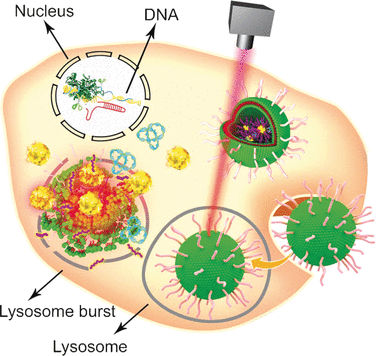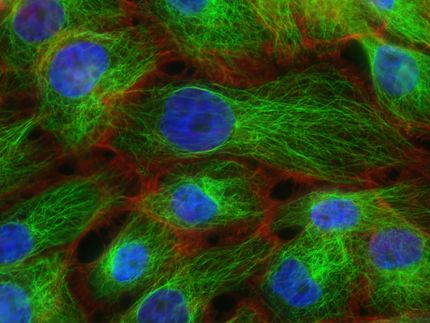Multifunctional platform for the delivery of gene therapeutics
Thermo-triggered release of a genome-editing machinery by modified gold nanoparticles
Advertisement
Gene editing is one of the hottest topics in cancer research. A Chinese research team has now developed a gold-nanoparticle-based multifunctional vehicle to transport the “gene scissors” to the tumor cell genome. As the authors report, their nonviral transport and release platform of gene-editing systems has the additional advantage of combining hyperthermal cancer therapy with genetic modification.

© Wiley-VCH
Since its discovery in 2002, the bacterial antiviral defense strategy CRISPR-Cas9 has emerged as one of the most popular genome engineering approaches with wide applications in the fields of molecular biology and biomedicine. Using the CRISPR-Cas9 system, a target gene can be edited, knocked out, or inserted in eukaryotic cells in a relatively simple and convenient manner. However, one of its weak points is its sheer size, which demands the use of specific nonviral vehicles to deliver the large plasmid to the nucleus. Combining established lipid formulations with gold nanoparticles, Wenfu Zheng and his colleagues from the National Center for NanoScience and Technology, Beijing, China, in cooperation with medical scientists in Japan and China, have found and tested a multifunctional tool based on simple components that effectively delivers and releases the CRISPR-Cas9 system into tumors. Laser irradiation was used to disassemble the lipid–nanogold vehicle after its entry in the tumor cells and enable the CRISPR-Cas9 gene editing. The knockout of the targeted gene then led to apoptosis and tumor growth inhibition.
Gold nanoparticles are especially attractive carriers for various biological molecules because of their easy modification, stability, and light-irradiation response. To convert them into a versatile biological transport and delivery vehicle, the scientists first attached Tat peptides—which facilitate the crossing of the cell nucleus membrane—to gold nanoparticles. Then, the CRISPR-Cas9 plasmid containing the RNA targeting the Plk-1 gene—the knockout of which would severely impair tumor cell function—was attached to the Tat peptides through electrostatic interactions so that they would release their load right after entering the nucleus. Finally, the nanoparticular system was coated with a formulation of lipids to improve cellular uptake.
To test the system, cells and tumor-bearing mice were both administrated with the CRISPR-Cas9-plasmid-carrying nanogold vehicle, and the release of the gene-editing machine was triggered by a laser. “In this study, light irradiation caused the release of the Tat peptide from the gold nanoparticles in a time- and laser-intensity-dependent manner,” the authors explained. Other approaches are also possible as they pointed out: as the gold nanoparticles heat up upon irradiation, they could serve as thermotherapeutic agents themselves. In summary, this relatively simple design entailing gold nanoparticles, peptides, and lipids assembled into a sophisticated multifunctional carrier/release system could serve as a multifunctional delivery platform for various aspects of gene therapy.
Original publication
Peng Wang, Lingmin Zhang, Wenfu Zheng, Liman Cong, Zhaorong Guo, Yangzhouyun Xie, Le Wang, Rongbing Tang, Qiang Feng, Yoh Hamada, Kohsuke Gonda, Zhijian Hu, Xiaochun Wu, Xingyu Jiang; "Thermo-triggered Release of CRISPR-Cas9 System by Lipid-Encapsulated Gold Nanoparticles for Tumor Therapy"; Angew. Chem.; 2018
Peng Wang, Lingmin Zhang, Wenfu Zheng, Liman Cong, Zhaorong Guo, Yangzhouyun Xie, Le Wang, Rongbing Tang, Qiang Feng, Yoh Hamada, Kohsuke Gonda, Zhijian Hu, Xiaochun Wu, Xingyu Jiang; "Thermo-triggered Release of CRISPR-Cas9 System by Lipid-Encapsulated Gold Nanoparticles for Tumor Therapy"; Angew. Chem. Int. Ed.; 2018
Other news from the department science
Most read news
More news from our other portals
See the theme worlds for related content
Topic world Gene therapy
Genetic diseases once considered untreatable are now at the center of innovative therapeutic approaches. Research and development of gene therapies in biotech and pharma aim to directly correct or replace defective or missing genes to combat disease at the molecular level. This revolutionary approach promises not only to treat symptoms, but to eliminate the cause of the disease itself.

Topic world Gene therapy
Genetic diseases once considered untreatable are now at the center of innovative therapeutic approaches. Research and development of gene therapies in biotech and pharma aim to directly correct or replace defective or missing genes to combat disease at the molecular level. This revolutionary approach promises not only to treat symptoms, but to eliminate the cause of the disease itself.


















































